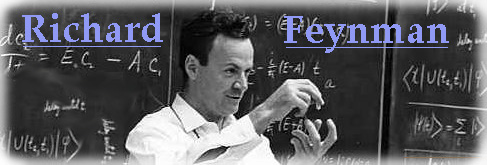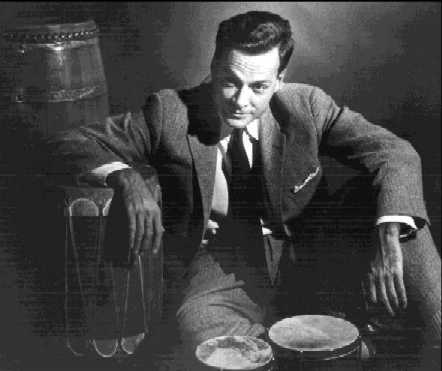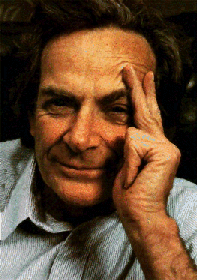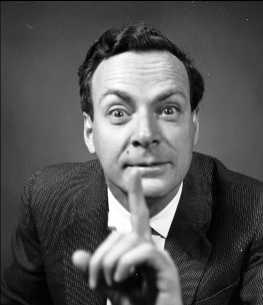
Now to a lot of us, Physics is a very boring subject and anyone interested in it must also be boring. Well this is probably due mostly to the Physics teachers we had to endure at school! Now if we'd all had teachers like Richard Feynman, we'd be buzzing about it all the time and how totally wacky and amazing and wonderful the world of general relativity and quantum physics is!
So, OK, Richard Feynman was a physicist but most definitely not one out of the normal mould. He was both intellectually brilliant and fun-loving: an extremely unusual combination! His razor-sharp mind was balanced by an equally sharp wit, which often manifested itself in the pursuit of extremely amusing practical jokes.
Feynman also took great joy in imparting his knowledge to others, through teaching. His lectures are still renowned, particularly those from his Cornell University days, which formed the basis of the famous book, "The Character of Physical Law". This volume is often used as degree course accompaniment because of the clarity and thought provoking style of the texts. Mainly though, Richard was renowned for his animated presentation style infront of audiences of non-scientific people: particularly on a large stage, which would allow him free range of movement to express himself. In this environment he never failed to "bring the subject alive" and allow the ley person to see the cool side of physics!

As you can see from the picture above, the other part of Richard Feynman's character that was unique amongst his peers, was his love for the non-conventional. His penchant for playing the bongos, brought him almost as much notoriety as his inspirational teaching style. Indeed, he became known as the "drum-playing physicist" and it should be noted that this was at a time when science was seen as very "stiff-collared" subject, only accessible to austere men wearing spectacles. During his time at Los Alamos, where the development of the atomic bomb obviously necessitated high security, Feynman found great amusement in bucking the system by picking locks. He even removed a door and relocated it once, just to see how confused the security "police" would become! His other favourite pastime, was to sneak out of a hole in the Los Alamos perimeter fence after having once checked in at the security post: the reaction on the guards' faces on seeing another "Feynman" arriving for the day's work, was apparently priceless.
Richard Feynman's achievements in the field of Quantum Physics remain as some of the key advances in theoretical thinking made during the 20th century. From an early age, it seemed clear that he was destined for greatness. He was only 24 years old when he started working at the Los Alamos National Laboratory. At that age, he had already built up a reputation as a boy genius. He was sent to the laboratory to observe and report back to his colleagues at Princeton University. In view of the fact that he had such a keen intellect, Feynman was requested to stay on at the laboratory in the Theoretical Division.
Feynman's
director was Hans Bethe, head of the Theoretical Division of the
Los Alamos National Laboratory. Feynman was charged to work on
diffusion problems. Ironically, the two men had divergent
personalities, yet they got along very well. Hans Bethe was a
methodical thinker; he would work problems through to the end and
make sure that all of the minus signs were in place and that there
was no flaw in the logic. Feynman, on the other hand, was
lightning-quick and would make some mistakes in judgment.
However, sometimes he would also see a solution that no one else
would even think of seeing.
Feynman had great skill in solving mathematical formulas in his head. He and Bethe would have contests to see who could first come up with numerical answers for different equations. One day, making his rounds about the laboratory, Feynman found a man struggling with an particularly complicated formula, a nonlinear three-and-a-half order equation. Feynman discovered a shortcut to the formula. With Hans Bethe, they invented a new and general method for solving third order equations. The second order had been manageable for several centuries but Feynman's invention was a precise and practical way of moving on an order.
J. Robert Oppenheimer had said of him:
"He is by all odds the most brilliant physicist here, and everyone knows this. He is a man of thoroughly engaging character and personality, extremely clear, extremely normal in all respects, and an excellent teacher with a warm feeling for physics in all its aspects."
Richard was, apparantly unlike most scientists, a very human character. This is made so clear by the story of his realtionship with his first love, Arline: as depicted by the movie "Infinity".
Infinity Directed by Matthew
Broderick 
Starring Matthew Broderick, Patricia Arquette
Her name was Arline and she was the most popular girl around. Richard was smitten from the first moment he saw her, playing the piano and singing at a teenage party in Far Rockaway, the New York City suburb in Queens. It was 1934 and their hopes were high - he to become a scientist, she to become an artist. They were deeply in love and the world was their oyster.
INFINITY, the film, is inspired by a true love story, that happened in the years before and during World War 11, in a time and a place before the loss of innocence. He was Richard Feynman, a brilliant young physicist, and she was the lovely Arline Greenbaum, the girl of his dreams, whose sensitivity opened his eyes to art and music and the beauty of nature. They placed high value on the honesty of their relationship, and prided themselves on their independent, maverick spirit. "What do you care what other people think?!" they would tease each other.
But their carefree world was shattered when Arline fell ill and was finally diagnosed with tuberculosis, a highly contagious and, at that time, incurable disease. Loving her as much as he did and determined as he was to be with her and take care of her, he married her, against his concerned family's wishes and protests.
A trained empiricist who always challenged conventional wisdom, Richard always tried to rationalize the mysteries of life, but, while he could probe the depths of atomic physics, he had to accept that her illness was beyond his understanding and control - beyond the power and limits of "modern" science.

The space shuttle Challenger crash inquiry also provided a platform for Richard's talents, during his later years. He was asked to take part in the investigations in view of his pragmatic approach to complex problems. Feynman certainly didn't disappoint the authorities, although they might have done well to considered his devil's advocate nature before asking him to appear at a live televised hearing. Little did they know that Feynman had uncovered the reason for the failure of the solid fuel booster rockets and that he wasn't going to be persuaded to conceal his findings. He knew that the cold weather had caused the rubber O-rings that seal the booster joints, to become brittle and prone to failure. So, while the others present deliberated over bureaucracy, Feynman asked for a glass of iced water, into which he secretly placed a piece of O-ring material. Quite dramatically and in full view of the cameras, he then completely upstaged all the government officials, by easily breaking the rubber and putting the explanation of the tragic failure beyond all doubt.
Richard Feynman on Teaching
"The Dignified Professor"
I don't believe I can really do without teaching. The reason is, I have to have something so that when I don't have any ideas and I'm not getting anywhere I can say to myself, "At least I'm living; at least I'm doing something; I am making some contribution" -- it's just psychological. When I was at Princeton in the 1940s I could see what happened to those great minds at the Institute for Advanced Study, who had been specially selected for their tremendous brains and were now given this opportunity to sit in this lovely house by the woods there, with no classes to teach, with no obligations whatsoever. These poor bastards could now sit and think clearly all by themselves, OK? So they don't get any ideas for a while: They have every opportunity to do something, and they are not getting any ideas. I believe that in a situation like this a kind of guilt or depression worms inside of you, and you begin to worry about not getting any ideas. And nothing happens. Still no ideas come. Nothing happens because there's not enough real activity and challenge: You're not in contact with the experimental guys. You don't have to think how to answer questions from the students. Nothing!
In any thinking process there are moments when everything is going good and you've got wonderful ideas. Teaching is an interruption, and so it's the greatest pain in the neck in the world. And then there are the longer period of time when not much is coming to you. You're not getting any ideas, and if you're doing nothing at all, it drives you nuts! You can't even say "I'm teaching my class."
If you're teaching a class, you can think about the elementary things that you know every well. These things are kind of fun and delightful. It doesn't do any harm to think them over again. Is there a better way to present them? The elementary things are easy to think about; if you can't think of a new thought, no harm done; what you thought about it before is good enough for the class. If you do think of something new, you're rather pleased that you have a new way of looking at it.
The questions of the students are often the source of new research. They often ask profound questions that I've thought about at times and then given up on, so to speak, for a while. It wouldn't do me any harm to think about them again and see if I can go any further now. The students may not be able to see the thing I want to answer, or the subtleties I want to think about, but they remind me of a problem by asking questions in the neighborhood of that problem. It's not so easy to remind yourself of these things.
So I find that teaching and the students keep life going, and I would never accept any position in which somebody has invented a happy situation for me where I don't have to teach. Never.
This disertation from Richard is about people using the word "science" to describe something that isn't really based on known facts ....... but everybody makes out that it is! Many of us will have come across this sort of thing in business training: let's face it there are no real laws governing market trends and economics! He calls it Cult Cargo Science. Read on for his explanation:
During the Middle Ages there were all kinds of crazy ideas, such as that a piece of rhinoceros horn would increase potency. Then a method was discovered for separating the ideas -- which was to try one to see if it worked, and if it didn't work, to eliminate it. This method became organized, of course, into science. And it developed very well, so that we are now in the scientific age. It is such a scientific age, in fact, that we have difficulty in understanding how witch doctors could ever have existed, when nothing that they proposed ever really worked -- or very little of it did.
But even today I meet lots of people who sooner or later get me into a conversation about UFO's, or astrology, or some form of mysticism, expanded consciousness, new types of awareness, ESP, and so forth. And I've concluded that it's not a scientific world. Most people believe so many wonderful things that I decided to investigate why they did. And what has been referred to as my curiosity for investigation has landed me in a difficulty where I found so much junk that I'm overwhelmed. First I started out by investigating various ideas of mysticism and mystic experiences. I went into isolation tanks and got many hours of hallucinations, so I know something about that. Then I went to Esalen, which is a hotbed of this kind of thought (it's a wonderful place; you should go visit there). Then I became overwhelmed. I didn't realize how MUCH there was at Esalen there are some large baths fed by hot springs situated on a ledge about thirty feet above the ocean. One of my most pleasurable experiences has been to sit in one of those baths and watch the waves crashing onto the rocky slope below, to gaze into the clear blue sky above, and to study a beautiful nude as she quietly appears and settles into the bath with me.

One time I sat down in a bath where there was a beatiful girl sitting with a guy who didn't seem to know her. Right away I began thinking, "Gee! How am I gonna get started talking to this beautiful nude woman?" I'm trying to figure out what to say, when the guy says to her, "I'm, uh, studying massage. Could I practice on you?" "Sure", she says. They get out of the bath and she lies down on a massage table nearby. I think to myself, "What a nifty line! I can never think of anything like that!" He starts to rub her big toe. "I think I feel it", he says. "I feel a kind of dent -- is that the pituitary?"
I blurt out, "You're a helluva long way from the pituitary, man!" They looked at me, horrified -- I had blown my cover -- and said, "It's reflexology!" I quickly closed my eyes and appeared to be meditating. That's just an example of the kind of things that overwhelm me. I also looked into extrasensory perception, and PSI phenomena, and the latest craze there was Uri Geller, a man who is supposed to be able to bend keys by rubbing them with his finger. So I went to his hotel room, on his invitation, to see a demonstration of both mindreading and bending keys. He didn't do any mindreading that succeeded; nobody can read my mind, I guess. And my boy held a key and Geller rubbed it, and nothing happened. Then he told us it works better under water, and so you can picture all of us standing in the bathroom with the water turned on and the key under it, and him rubbing the key with his finger. Nothing happened. So I was unable to investigate that phenomenon.
So we really ought to look into theories that don't work, and science that isn't science. I think the educational and psychological studies I mentioned are examples of what I would like to call cargo cult science. In the South Seas there is a cargo cult of people. During the war they saw airplanes with lots of good materials, and they want the same thing to happen now. So they've arranged to make things like runways, to put fires along the sides of the runways, to make a wooden hut for a man to sit in, with two wooden pieces on his head like headphones and bars of bamboo sticking out like antennas -- he's the controller -- and they wait for the airplanes to land. They're doing everything right. The form is perfect. It looks exactly the way it looked before. But it doesn't work. No airplanes land. So I call these things cargo cult science, because they follow all the apparent precepts and forms of scientific investigation, but they're missing something essential, because the planes don't land.
Now it behooves me, of course, to tell you what they're missing. But it would be just about as difficult to explain to the South Sea islanders how they have to arrange things so that they get some wealth in their system. It is not something simple like telling them how to improve the shapes of the earphones. But there is one feature I notice that is generally missing in cargo cult science. That is the idea that we all hope you have learned in studying science in school -- we never say explicitly what this is, but just hope that you catch on by all the examples of scientific investigation. It is interesting, therefore, to bring it out now and speak of it explicitly. It's a kind of scientific integrity, a principle of scientific thought that corresponds to a kind of utter honesty -- a kind of leaning over backwards. For example, if you're doing an experiment, you should report everything that you think might make it invalid -- not only what you think is right about it: other causes that could possibly explain your results; and things you thought of that you've eliminated by some other experiment, and how they worked -- to make sure the other fellow can tell they have been eliminated.
Details that could throw doubt on your interpretation must be given, if you know them. You must do the best you can -- if you know anything at all wrong, or possibly wrong -- to explain it. If you make a theory, for example, and advertise it, or put it out, then you must also put down all the facts that disagree with it, as well as those that agree with it. There is also a more subtle problem. When you have put a lot of ideas together to make an elaborate theory, you want to make sure, when explaining what it fits, that those things it fits are not just the things that gave you the idea for the theory; but that the finished theory makes something else come out right, in addition.
For more information on Richard Feynman, you might want to read: